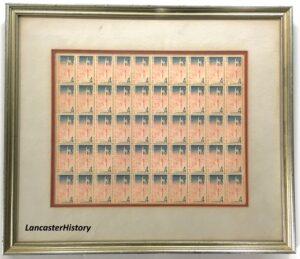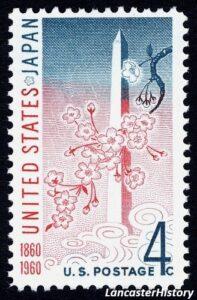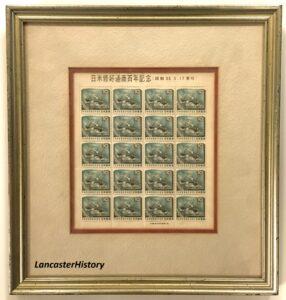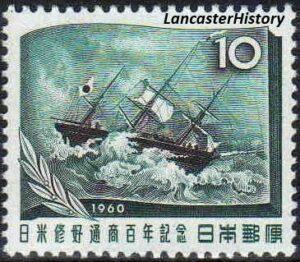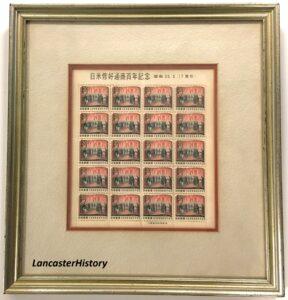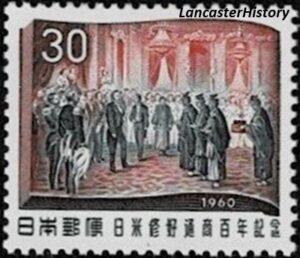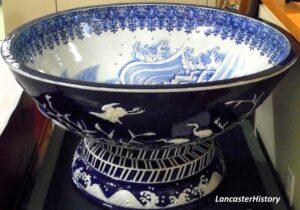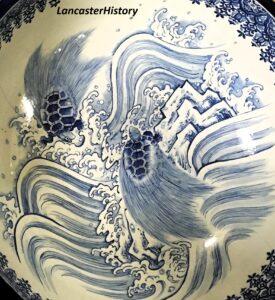Stamp Act: Commemorating the Centennial Visit of the Japanese Embassy to the United States
A Centennial Celebration – U.S. Postage Stamp
On September 28, 1960 the United States Post Office issued a 4-cent first class stamp to commemorate the centennial of the Treaty of Amity and Commerce between the United States and Japan. That 1860 treaty officially opened trade between the two countries, provided for diplomatic relations, and opened five Japanese ports to American ships. The stamp features an image of the Washington Monument and Japanese cherry blossoms. The cherry blossoms featured on the stamp are symbolic of the over 3000 trees that Japan gifted to the United States in 1912 as a symbol of friendship and ongoing cooperation.
Japanese American author Gyo Fujikawa (1908-1998) designed the treaty commemorative stamp. Fujikawa is perhaps best known for her work as the writer and illustrator of over fifty children’s books. During her long career she also designed six postage stamps for the U.S. Postal Service, including the 1997 32-cent yellow rose self-adhesive stamp. Her 1960 artwork marked the first time a Japanese American artist illustrated a U.S. postage stamp.
A Centennial Celebration – Japanese Postage Stamps
Japan issued two stamps in commemoration of the 100th anniversary of the treaty between Japan and the United States. The ship pictured on the 10-yen stamp is the Kanrin Maru, the Japanese ship that accompanied the American ship Powhatan on which the first Japanese delegation (referred to as an embassy) traveled. After arriving in San Francisco, the Japanese mission continued by boat to Panama (rather than across the continent), crossed the isthmus by train, and again traveled by sail to Washington where they met with President James Buchanan. The image pictured on the 30-yen stamp is taken from a colorized wood engraved image from the May 26, 1860 edition of Harper’s Weekly titled “Reception of the Japanese Embassadors [sic] by the President at the White House, May 17, 1860.”
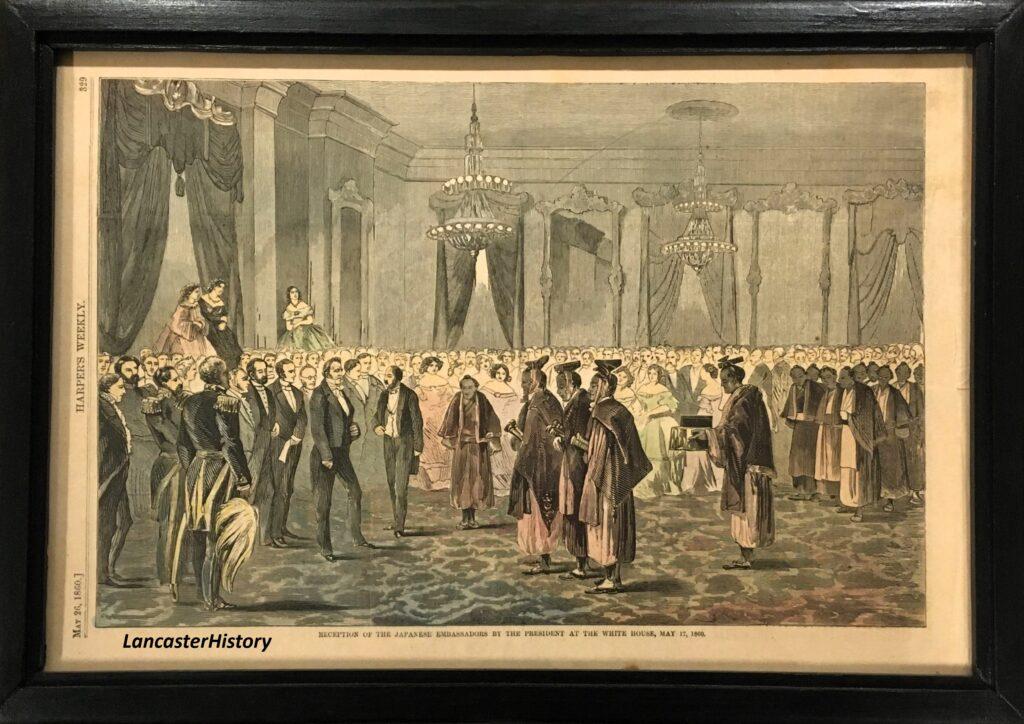
A Historic Visit
In 1853, Commodore Matthew Perry negotiated the Kanagawa Treaty opening Japan’s ports to American ships and allowing the United States to open a consulate in the country. Five years later, in 1858 during the administration of James Buchanan (1857-1861), American Townsend Harris negotiated the Treaty of Amity and Commerce between the two governments. Harris served as first consul general to Japan beginning in 1855 during the administration of Buchanan’s predecessor Franklin Pierce (1853-1857). He was officially appointed Minister Resident in 1859 and served in that post until recalled in 1862.
The treaty only became official with the exchange of treaty ratifications in 1860, when the Tokugawa government of Japan sent its first embassy to the United States. The visit marked the first time Japan had direct contact with foreign culture and civilization after nearly 250 years of isolation. Throughout their seven-week visit, the embassy spent three weeks in Washington before visiting Baltimore, Philadelphia, and finally New York. Everywhere they went, Americans greeted their Japanese visitors with great excitement, hosting parades, balls, and dinners in their honor.
The May 26, 1860 Harper’s Weekly also included this image with the caption “ The Landing of the Japanese Embassy, with the Treaty in a Box, at the Navy Yard, Washington.”
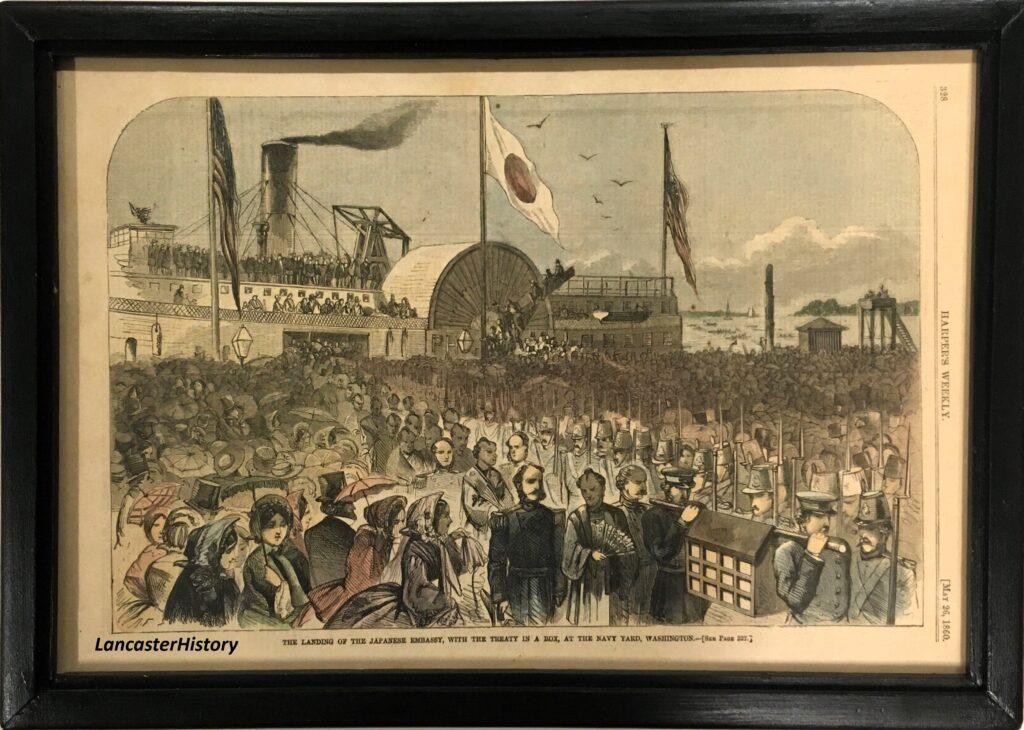
During their official visit to President Buchanan at the White House, the embassy provided Buchanan with a number of gifts – both personal and official –including the large Emperor’s Porcelain Bowl that can be viewed in the Decorative Arts Center on the lower level of the LancasterHistory museum. The bowl includes the Emperor’s personal symbol and indicates his deep regard for President Buchanan and desire for friendly relations between his country and the United States. The symbol of the turtle is popular in Japanese culture and history; a symbol of longevity and good fortune with a connection to Tokugawa leyasu, the founder of the powerful Tokugawa Shogunate that ruled Japan for 265 years from 1603 until the Meiji Restoration in 1868. The bowl was made by Jihei Kawamoto as one of two bowls for sake, Japanese rice wine.
Following the assassination of Abraham Lincoln, Buchanan’s presidential successor, Mrs. Lincoln marked the bowl as an item to sell to pay for some of the debts she was struggling under. Her friend and advisor, George Riggs advised her not to sell the bowl. He made her an offer on the bowl and she sold it to him. Mr. Rigg’s daughter, Jane, inherited the bowl and eventually bequeathed it to Miss Mary F. McMullen who in turn bequeathed it to Mr. J.B. McMullen. A distant relative of James Buchanan, Mr. Wylie Buchanan, purchased the bowl from McMullen and donated it to the Wheatland Collection in 1960. One hundred years later, the bowl has come full circle to tell a unique history between Japan and James Buchanan.
Special thanks to Dr. Natalia Doan, University of Tennessee, Knoxville for providing the translation of Japanese to English.
From Object Lessons

